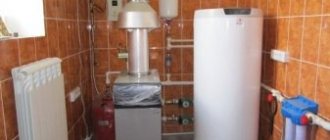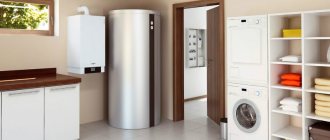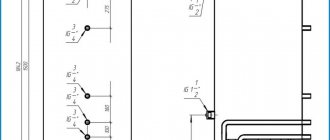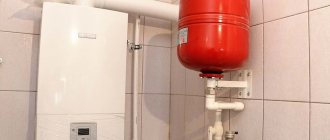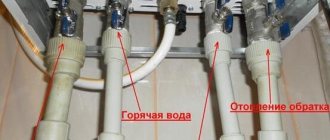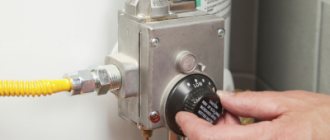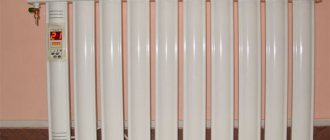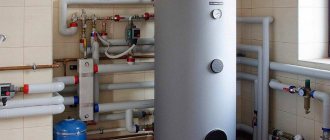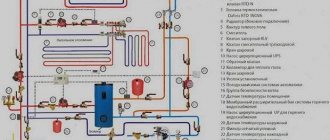An indirect heating boiler is considered the most economical and practical for heating water, since it does not have a heating element in its design. It heats the water by interacting with external thermal units, such as central heating, a boiler or a solar panel. Although some models are improved with an additional heating element, these are already combined models.
In our article we will look at the principles of operation, design, selection rules and popular models of these units. As well as questions about descaling them and other important points.
Indirect heating boiler
Many owners of private houses are wondering how to use a heating system to supply their home not only with heat, but also with hot water. Why does such a question arise at all, since the market is simply teeming with offers of electric and gas storage and instantaneous water heaters? Everything is very banal - electricity is not cheap, and geysers are not able to provide a constant temperature that is comfortable for use. Therefore, indirect heaters are an excellent option for a home with heating from a gas boiler , moreover, they are economical.
Types of water heaters
Gas water heaters are not new. Previously, speakers were bulky and inconspicuous, but today they are compact devices with an aesthetic appearance. The principle of operation remains the same. It consists in the fact that cold water, entering a copper heat exchanger, is heated by natural gas. The undoubted advantages of such equipment are instant heating of any volume of water and the low cost of natural gas.
These products, from both domestic and foreign manufacturers, are widely represented in the distribution network. To be completely confident in the quality of such devices, you should choose products from well-known and reputable companies. Among them are brands such as Neva, Ariston, Elektrolux and many others. High productivity, high power and low cost of gas resources contribute to high consumer demand for this equipment. Modern speaker models are divided according to the ignition method. They can be:
- automatically - the device starts working the moment the mixer tap is opened;
- semi-automatic - manual ignition of the wick is required to start the equipment.
Relatively new equipment is turbocharged speakers.
The operation of this device is not affected in any way by the presence of draft in the chimney pipe. A turbine is a built-in fan designed to pump air masses into the combustion chamber and remove combustion products from it. The automatic operating mode of the system ensures the reliability and safety of the device. The column is equipped with sensors that record such important indicators as: pressure and temperature of the water, as well as the heat exchanger. Increasing the standards of these indicators leads to automatic blocking of the system.
For consumer convenience, manufacturers supplement the equipment with special options. These may include a convenient display, various indicators (on and heating) and a thermometer.
Boiler – storage water heater. Available in two types: gas and electric. The electric heater includes: a thermally insulated tank, a tubular heater and a water heating regulator. Water entering the tank is heated and used as needed. Gas boilers can be:
- with a closed combustion chamber and forced draft;
- with an open chamber and natural draft.
The second heater option requires a chimney. Some models have additional options that ensure comfortable and safe use.
An electric boiler is used to supply hot water not only to residential buildings, but also to industrial facilities. Water enters the internal tank and is heated to a set temperature. Automatic operation of the heating elements allows you to maintain the temperature regime. Periodic heating contributes to economical energy consumption. This device is installed in the water supply system. A dense layer of thermal insulation of the tank helps reduce energy consumption for heating. The inner surface of the tank is treated with a special anti-corrosion coating. Devices with a tank whose flask is made of stainless steel are considered more reliable. They are distinguished by reliability and durability, unlike specimens with an enameled tank.
Device
An indirect heating boiler is a large cylinder-shaped tank. Its design consists of the following elements:
- frame;
- thermal insulation;
- stainless steel tank;
- heat exchanger;
- magnesium anode;
- thermometer.
Thermal insulation is laid between the body and the boiler tank to minimize heat loss to 3-4 degrees per day. The heat exchanger is a curved spiral tube made of steel or brass , which is also called a coil. The coil itself is the most important part of the boiler and the more curls it has, the more efficient the heat exchange. Usually it has a very complex structure and is located closer to the bottom, which makes it possible to evenly heat the entire volume of water.
The magnesium anode, which is also used in conventional electric water heaters, is designed to combat tank corrosion caused by galvanic processes. The anode will take over all electrochemical reactions, leaving other metal parts of the system untouched. especially important to protect welding seams from destruction , so periodically it will be necessary to replace the worn magnesium anode with a new one.
Modern boiler models combine several heat sources. They can work even after the heating season, using electricity, gas for heating, and some models even heat water using the sun. Such modifications have two tubular heat exchangers at once, one for water from the heating system, the other for an alternative source.
Some useful nuances
Before connecting an electric boiler to a regular outlet, be sure to check the condition of your wiring. A mismatch between the power of the heater and the old wiring can lead to a short circuit and even a fire.
It is necessary to check not only the outlet, but also the distribution meter. In old Soviet-built houses, it may be necessary to install an additional circuit breaker.
Most models of storage boilers are wall-mounted - but some of them can be installed in the space under the sink.
The shape of tanks in storage boilers can be not only classically cylindrical, but also oval. The boiler can also be installed horizontally, so you can fit into almost any interior.
It is desirable that the inner surface of the boiler tank have an antibacterial coating. This will prevent the water from “blooming” when it stagnates or the formation of mold.
The coating in the boiler tank made of the following materials most effectively prevents the development of corrosion:
- Glass porcelain will delay the formation of rust for 3 years.
- A tank enameled on the inside will last up to 5 years.
- Titanium-based enamel will protect the tank for up to 7 years.
- A stainless steel tank will last about 20 years.
In any case, extending the life of your heating device will be helped by regular maintenance and cleaning, and preventing the formation of limestone deposits.
Video - How to choose a water heater
Work principles
Usually an indirect heating boiler is purchased together with the boiler. There are also double-circuit boilers that can provide households with still warm water. But the volume of heated water in double-circuit boilers is small, and an indirect heating boiler can heat much larger volumes , due to which the supply of hot water will be carried out without interruptions.
As indicated in the title of the article, an indirect heating boiler is a type of water heater that operates through external heating systems. The coolant (water) is supplied from these heating sources through a coil located inside the tank. The water in the boiler is heated by circulating coolant through the coil , which is possible thanks to the pump. The walls of the coil serve as a heat exchange surface. Once the water temperature reaches a certain point, the pump automatically turns off. Naturally, during operation of such a boiler, the temperature in the heating system decreases slightly. But there is no need to worry about this; if everything is installed correctly, the temperature changes are almost unnoticeable.
To ensure that such a system has as little heat loss as possible, it is insulated with special insulation materials, such as polyurethane, polystyrene foam, etc. In fact, it resembles a huge thermos that holds heat perfectly.
Water is supplied to the boiler through the inlet pipe, which is connected to the heating system. Through this pipe, hot water enters the coil and heats the water, and the outlet pipe supplies hot water to the place of its use.
Types of water heaters
First, let's figure out what kind of heaters exist in principle, since a boiler or a gas water heater are far from the only ones, but they are the most popular on this list. All devices are divided into two categories according to heating method:
- storage (boilers), where water is collected in a certain tank and heated there to a certain temperature (no more than 85°);
- flow-through (columns) equipped with heating elements, passing through which the water is instantly heated. The temperature in this case does not exceed 75°.
Both types operate on both electricity and gas. In addition, there are indirect heating boilers, but if assessed by popularity among consumers, this device is at the lowest level. As a rule, they choose between two main options - a water heater or a gas water heater. These devices, in terms of quality characteristics, are more consistent with household needs and meet approximately the same tasks. But which one to choose - read on.
An electric boiler creates a very high current in the network, which is unacceptable for apartments and houses with old wiring. The same can be said about power limitations - for example, in dachas where the maximum allowed is 5 kW and a single-phase meter, the boiler will not work.
A gas boiler is also not the most popular product, therefore, if there is a centralized gas pipeline, it is much more convenient and expedient to use a water heater. In private houses where a gas pipeline is already connected, it is recommended to install double-circuit boilers, where one circuit works for heating, the second, respectively, for heating water.
So, in order to compare which is better: a gas water heater or an electric water heater, we will highlight 3 main criteria:
- ease of use;
- energy price;
- complexity of installation;
- price.
Geyser - pros and cons
Since Russia is one of the largest suppliers of blue fuel in the world, for us it is the most inexpensive energy source, which is beneficial in terms of maintenance costs.
Ease of use lies in the ability to continuously supply hot water, but it is important to choose the right power of the gas burner, otherwise you risk not getting the desired temperature.
Power has 3 stages:
- 17-19 kW;
- 20-24 kW;
- 26-31 kW.
When using a unit in an apartment for one point, a power of 20-24 kW is sufficient for a family of 3-5 people. For a private home, it is more profitable to have such a unit, since it has a reduced water pressure (from 0.02 MPa) and saves gas consumption.
All modern models are equipped with winter-summer regulators, which allows you to save up to 50% on service fees.
At the price of equipment - for 6000 rubles. You can buy a good speaker. For example, Zenden brand equipment will cost 49,600 rubles, Oazis and Zanussi - 5,600 rubles. etc.
Flaws:
- For installation, it is necessary to coordinate the project with the controlling organizations, including the gas service. On average, installation, provided gas is available, will cost up to 2,000 rubles.
- A prerequisite for operation is the presence of a chimney and high-quality ventilation.
During operation, it is important to monitor the air flow into the apartment and the operation of ventilation. It is recommended to open the windows for ventilation. This is especially true for sealed plastic windows - in winter they are set to micro-ventilation mode.
- The need for systematic inspection of the column and cleaning of soot. Parts made of non-ferrous metals from constant contact with flames fail and require replacement.
- Its efficiency factor (92%) is lower than that of a boiler - 99%. Efficiency in summer is different from winter. In summer, the water heater produces 6-7 l/min, in winter 4-5 l/min. In winter, when heating ice water, even operating in maximum mode, the column is not able to heat it sufficiently.
Equipment classification
The main gradation is carried out according to the method of igniting the wick:
- Automatic
They begin to function immediately after opening the water tap;
- Semi-automatic
To turn on the unit, first manually light the wick. In such devices, the flame strength should be adjusted when the water pressure changes.
It cannot be strengthened by opening a “cold” tap. If there is a sharp decrease in water pressure, you must immediately reduce the flame in the wick or turn it off completely. Otherwise, the column may burn out or even explode from overheating.
In automatic analogues, its adjustment and shutdown occurs without human intervention.
- Turbocharged
A fan (turbine) is attached to the combustion bunker to enhance air movement. It also expels exhaust air along with combustion products. With this improvement, the operation of the unit does not depend on the presence of draft in the chimney pipe.
This model appeared on the market quite recently. It operates in automatic mode, ensuring safety and reliability. To monitor the work process, sensors are placed on the body, indicating water pressure, its temperature and heat exchanger parameters. At the slightest imbalance, the unit automatically switches off immediately.
VIDEO: How to choose a geyser
Electric boiler - advantages and disadvantages
When understanding whether a boiler or a flow-through device is better, you need to understand that the work of the former is structured in a completely different way. Its design includes a reservoir of a certain volume, into which water is collected and heated by built-in heating elements (tubular electric heaters). On average, it takes at least 2 hours to heat water, during which a temperature of 60° is reached. Such equipment is convenient in that heating is carried out automatically, even if there is no water intake.
Among the main advantages we highlight:
- simple installation that you can do yourself;
- no additional devices (chimney or ventilation);
- does not depend on water pressure;
- cost of equipment.
Most models can be repaired. Subject to certain conditions, in particular, replacement of the magnesium anode, the service life is at least 8 years.
Flaws:
- long time for heating - realizing that it is more profitable to immediately heat water for the whole family, you need to choose a tank according to flow rate. For example, for a family of 4 people you need a boiler with a tank volume of 80 liters or more;
- large size - a large tank is difficult to place in a small apartment. As a rule, they are installed in the bathroom and the fastening must be provided in such a way that a person does not touch it.
VIDEO: How to choose a boiler
Gas water heater
This heating device combines a column and an electric boiler. This is where all its pros and cons follow.
On the one hand, it is easy to install and holds a large supply of hot water, on the other hand, the use of natural gas imposes strict obligations for approval by licensing authorities and difficult installation. A chimney and ventilation are required for its operation.
Comparative characteristics
| Comparison factors | Geyser | |
| Large object requiring at least a square meter of free space | Compact dimensions | |
| Difficulty in installation | Do-it-yourself installation | For legal installation, it is necessary to collect a package of documents and approve the project. After receiving official permission, the installation is carried out by qualified craftsmen with a certain clearance category. |
| Installation Requirements | Availability of proper electrical wiring and sufficient permitted power | Availability of chimney and ventilation. Connection only via metal pipes. The wall where the equipment is mounted is covered with heat-resistant material at least 1 cm thick |
| Warm-up time | To obtain a comfortable temperature and volume for the whole family, it takes 3-4 hours | Instant water heating |
| Water temperature at several points | Does not change - water comes out at the same temperature at all points | When drawing water from even two points, the temperature at the latter will be significantly lower |
| Which is more economical? | On average, heating water consumes 3 kW of energy per hour | Modern equipment consumes about 2.3 cubic meters of liquefied gas |
| Maintenance | It requires water filtration, removal of lime deposits from the heating element, and cleaning of the tank. If there is a magnesium anode, maintenance is reduced only to its regular replacement | Regularly checking gas pressure |
As you can see, there is no clear answer as to which is more profitable and which is better: a boiler or a water heater. Both devices have both advantages and disadvantages. The main disadvantage of a storage water heater is its size, despite the fact that for connection you only need an outlet and pipe routing. A gas appliance has a minus in the complexity of installation, but in the future there is a minimum of hassle and lower operating costs.
When choosing an electric boiler, be sure to install a magnesium anode. It neutralizes the effect of limescale on the heating element and significantly extends its service life.
What models are popular on the market
Our article would not be complete if we did not provide examples of models that are popular among users. Statistics were carried out based on data from online stores.
TOP boilers
The absolute leader in the water heating devices market. The reservoir consists of two communicating sections, the inner part is covered with enamel with silver ions. 2 heating elements operate alternately, which saves energy consumption. Equipped with an audible error indicator and a high degree of protection. Cost - 8260 rub.
According to statistics, THERMEX produces the most reliable equipment in the middle price category. The warranty period is also the highest - 10 years. The inside of the tank is treated with anti-corrosion enamel. Equipped with an indicator panel The cost of a tank with a volume of 80 liters is 9600 rubles.
The tank is made of stainless steel and has high-quality thermal insulation. Bottom water connection. Power - 2 kW, maximum heating temperature 75°. 7 year warranty on the tank, 2 years on structural elements. Cost 24,000 rubles for 100 liters.
Rating of geysers
Equipped with electronic ignition from AA batteries. Performance and heating controls are provided. The burner is made of stainless steel, the heat exchanger is copper. Operation at minimum pressure is possible. Cost 5200 rub.
The Russian manufacturer has developed equipment that optimally meets the needs - automatic ignition as soon as the pressure is sufficient, energy efficiency and the absence of a constant flame in the pilot burner. Cost 8500 rub.
Another example of a Russian manufacturer with more than compact dimensions. And although its productivity is low - 9 liters per minute with a power of 17.9 kW, it has an affordable price of 7,000 rubles. makes it one of the most popular on our market.
VIDEO: What to choose - boiler or geyser
A gas instantaneous water heater (gas water heater) or an indirect heating boiler are excellent solutions if you have no hot water supply at all or its stability leaves much to be desired.
Homeowners without a centralized hot water supply have to resolve the issue on their own. The solution is to buy a gas water heater or water heater. The first option is much more economical than the second - it not only provides constant availability of hot water, but also good gas savings.
According to the starting method, gas water heaters come with piezo ignition - a spark is created and ignition is carried out by pressing a special button and with electric ignition, when the spark is created automatically from electricity generated by batteries. In some models, instead of batteries, a turbine is used, which is driven by a water flow. This device allows you to significantly save gas.
One of the main parameters that must be taken into account when choosing a geyser is its useful power. Moreover, this does not mean that the device heats the water more strongly - the power affects the rate of heating of the water. By power, devices are divided into three groups: 18-19 kW, 22-24 kW and 28-20 kW.
Buying a geyser is a solution for those who care about the instant supply of hot water, and not its volume. Such a device has the function of adjusting the water temperature, and the automation ensures the constancy of this indicator regardless of pressure changes.
If a heating boiler is installed in an apartment or house, then the issue with hot water supply can be solved differently - buy an indirect water heater. The water in such devices is heated to a certain point, after which the temperature remains stable until the water runs out completely. This method of heating water is very advisable to use in private homes, since a powerful heat exchanger and a large supply of heated water provide the required volume. Heating is carried out quite quickly, and using such a water heater is convenient and simple.
An indirect heater works like this: the coolant passes through a heating element - a coil, and warms up the water in the boiler. As a rule, the coil is made of ceramic and is connected to the boiler using a heating circuit. The device is equipped with a temperature indicator, and water is heated to 60 degrees in less than half an hour.
Indirect heaters are located near heating boilers. According to the type of design, they can be floor- or wall-mounted, but in the latter case their capacity does not exceed two hundred liters.
The decision to install an indirect heating boiler is also justified by the fact that if the boiler is replaced, it will not be necessary to change it - these devices are compatible with any heating boilers.
Both types of this equipment have a number of features, including both advantages and disadvantages. If you don’t know what is better to choose - an indirect heating boiler or a gas water heater
, then we hope that our article will help you decide. So, a geyser is considered one of the most common methods of autonomous hot water supply. It is a flow-through water heater that heats cold water from the tap directly “on the fly.” Thanks to this, heating is carried out almost instantly, and the volumes of hot water supplied depend on the power of the column.
The gas water heater is compact and provides fast water heating. However, it requires that the house be connected to a centralized gas and, preferably, water supply. In many ways, the efficiency of such equipment depends on the pressure of the supplied cold water. Also, to install a gas water heater, a chimney is required, at least coaxial (for turbocharged models). In some cases, this may cause some inconvenience to the user.
As for the indirect heating boiler, it does not have a flow-through, but a storage principle of operation, accumulating hot water heated by a separate heating boiler in its container. Therefore, it is advisable to use this equipment (boiler + boiler) only in conjunction with each other. Some models of such water heaters have a built-in electric heating element that maintains a high water temperature. The advantage and, at the same time, disadvantage of this boiler is its bulkiness - it can store a large volume of liquid, but at the same time it requires a lot of space for its placement.
So, an indirect heating boiler or a gas water heater
— which equipment will be more profitable? The column is intended exclusively for flow-through heating of hot water in relatively small, domestic volumes. At the same time, the house must have a stable, good pressure of gas and cold water. It does not have a tank, so if the cold water supply is turned off, you will be left without hot water too. A gas water heater is ideal for apartments or houses with central heating, as well as a stable water and gas supply.
In turn, an indirect heating boiler is much more economical than a gas water heater, since it receives water already heated by the boiler and spends a minimum of energy maintaining its temperature. It does not require a gas pipeline to heat water; the boiler can operate on electricity or completely autonomously (using coal, wood, pellets). In addition, it stores hundreds of liters of liquid in reserve in its container, which is ideal for cases where increased DHW consumption is required. Its disadvantages include its bulky dimensions, as well as the very high cost of a set of a heating boiler and an indirect heating boiler (which, however, soon pays off).
Everyone knows such a pressing problem as instability of hot water supply. The water can be turned off at the most inopportune moment. Is there a way out of this unpleasant situation? Certainly! Retail chains offer a variety of water heaters. Among them, geysers and electric water heaters of various types (storage and instantaneous) are especially popular. This article is for those who want to find out what is better and more profitable.
How to choose the right boiler?
Important characteristics of an indirect heating boiler are:
- volume;
- coil material;
- tank material;
- insulation material;
- the presence of an additional heating element and alternative heating sources.
Boiler volume
You need to choose the volume of the boiler based on the power of your heating system , since it accounts for the load of water heating. If you buy a unit whose volume is too large, then there is a possibility that your heating system may not be able to cope with it. This risks the fact that the temperature of the water in the heating devices will be too low to heat the room. In order not to make a mistake, you need to find out the volume of the boiler coolant; it should be no more than 30-40% of the volume of water in the heating system, otherwise its performance will noticeably suffer.
It is very easy to determine what size boiler your family needs. On average, there are 60-80 liters per person for a shower. Heating 200 liters takes about 6 hours. Based on these figures, you need to take the volume of the boiler, which is enough to cover the needs of the family, taking into account the time until the next heating.
Materials
One of the most important parts of the boiler is the coil, so you need to inquire in advance about what it is made of. Cheap models have a steel coil that is simply welded to the tank. In more expensive models it is removable and made of brass , which is much better in many respects. Moreover, the removable version can be dismantled and descaled.
What the tank is made of is also very important, since a common problem with any water heater is leakage. Inexpensive models have a layer of enamel inside, but it quickly forms cracks due to temperature changes. And this, in turn, is fraught with rapid corrosion of the metal. It is best to buy those options in which the tank is made of stainless steel. It may be more expensive, but it will also last longer, provided that the magnesium anode is replaced in a timely manner.
The quality of the insulation is also an important factor in the effectiveness of such a system. Sometimes they use ordinary foam rubber, but it loses on many points. It is best if polyurethane and similar materials are used as thermal insulation.
Other options
In addition to the fact that the boiler can have two sources of indirect water heating, it can also be equipped with a heating element as a heat source outside the heating season. Such designs are much more expensive than conventional ones, but they are extremely practical.
The type of boiler can be of two types: wall-mounted or floor-mounted. It must match the type of heating system. So, if the system is wall-mounted, then the boiler should be of this type. Only models with a volume of less than 200 liters can be wall-mounted.
The best models with a heat exchanger
You can use such boilers only in winter, since the water will only be heated from the boiler. But you won’t spend a penny of extra money, because there will be no additional costs for electricity.
Baxi Premier Plus–150
This model is one of the recognized leaders among water heating equipment. Quality and reliability are guaranteed by the famous Italian manufacturer. Despite the rather high price, the device confidently occupies a leading position. After all, the quality of components and assembly is not satisfactory.
The internal tank of the unit is made of stainless steel and has a volume of 150 liters. To ensure fast and smooth heating, the “coil-in-coil” technology is provided. An additional heat-insulating layer made of polyurethane foam will minimize heat loss.
Main advantages:
- Possibility of floor or wall installation;
- quick heating to the desired temperature;
- if necessary, it is possible to equip it with a heating element;
- it is possible to connect to the circuit of the recirculation system;
- high installation characteristics, compatibility with many types of boilers.
Unpleasant moments:
- quite high cost;
- The temperature sensor is not compatible with all boilers.
Drazice OKC 125 NTR
A proven and unpretentious representative from a Czech manufacturer. Has proven itself superbly in Russian realities. The water heater can be connected to a gas or solid fuel boiler. Thanks to a specially developed circulation system, water heating occurs in a very short time.
Pros:
- not too demanding on coolant parameters;
- high quality workmanship;
- affordable price.
Minuses:
- designed for use under pressure no higher than 6 atmospheres, therefore not very suitable for installation in apartments (from central heating);
- The enameled tank has insufficient corrosion resistance.
Gorenje GV 120
An excellent model in the budget price category. Equipped with a 120-liter tank made of enameled steel. Heating is quite fast.
Advantages:
- very attractive price;
- Possibility of floor or wall installation;
- possibility of combination with any type of boiler;
- Full compatibility with central heating.
Flaws:
- enamel coated tank;
- the presence of only top wiring, and this is not always acceptable.
Protherm FE 200/6 BM
High-quality indirect heating boiler from a Slovak manufacturer. Perfectly compatible with many types of boilers. The tank holds 184 liters, which is quite enough for a family of several people. In order to reduce the formation of corrosion stains and scale, a titanium anode is used in the design. Rapid heating of water is due to the lower location of the tubular heat exchanger.
To eliminate the consequences of water overheating, the water heater is equipped with an additional protection system. Additional thermal insulation is provided through a polyurethane “coat”.
Pros:
- tank with antibacterial coating;
- possibility of quick draining through a special fitting;
- a temperature sensor that allows you to regulate the water heating temperature;
- high-quality assembly;
- price tag that does not boggle the imagination.
Minuses:
- there is no possibility of additional installation of heating elements;
- quite heavy weight.
Bosch WSTB 160-C
Excellent German quality at the best price. The model has a tank capacity of 156 liters and can be mounted on the floor under a wall-mounted boiler. The steel tank has a high-quality enamel coating to protect against rust. Water heating sensors and frost protection are installed. Can heat water up to 95 C.
Advantages:
- light weight and small size;
- magnesium anode to prevent corrosion;
- maximum heating time 37 minutes;
- affordable price.
Flaws:
No negative reviews found.
Advantages and disadvantages of indirect heating boilers
Like any other unit, such a boiler is in some ways better than other water heaters, and in some ways worse. Having assessed all the advantages and disadvantages, you can decide whether such costs are justified.
Advantages
What are the strengths of an indirect heating boiler?
- The main advantage of indirect heating is the low cost of hot water. No additional source of electricity or gas consumption is connected, so the consumption of these resources practically does not increase. The additional load on the indirect heating source is minimal. In winter, this method of heating water is very relevant.
- During the heating season, an indirect heating boiler makes it possible to reduce the load on the electrical network , because it uses the energy of the boiler to heat water.
- Possibility of heating large volumes of water.
- Supply of hot water to several points.
- Possibility of using alternative heat sources: sunlight, gas or electricity.
- There is no contact of the coolant with the heated water, so the inner surface of the coil always interacts with prepared water with a low percentage of salts.
As you can see, there are enough advantages; in fact, this is an ideal design for providing a family with hot water. Although there are also disadvantages, especially in those designs where only one indirect source is used.
Flaws
This boiler also has its weaknesses.
- The cost of such a unit is quite high. In addition, you need to take into account that it adds to the cost of the heating system. It is cheaper to buy an electric storage water heater or a double-circuit boiler separately.
- Heating of water takes longer than in electric storage boilers. To heat 100 liters of water, it will take several hours, during which the temperature in the heating system will be slightly reduced.
- The design of indirect water heating itself is quite cumbersome. It is usually installed near the boiler, sometimes a separate room is needed for this. At the very least, you need a carefully thought out place for this.
Gas water heaters: pros and cons
The biggest and main advantage of units of this type is the ability to provide the house with hot water for an unlimited time.
The burner of the device begins to heat the water almost immediately after opening the tap and will do this until the valve closes. This feature of geysers makes them the undoubted leader among all units in terms of comfort. The only condition: the thermal power of the burner must be enough for all consumers. Modern turbocharged units are equipped with electronic combustion intensity control systems, as a result of which changes in water pressure have virtually no effect on its final temperature. But if the thermal power of the gas water heater is initially selected incorrectly, then at high flow rates barely warm water will flow from all the mixers.
An important advantage of gas instantaneous heaters is their small dimensions, allowing the device to be squeezed into the smallest kitchen. Thanks to this, speakers are so popular among residents of small apartments
In addition, the product is quite reliable (if you do not take into account Chinese products) and repairable. Due to the fact that water supply networks in the post-Soviet space leave much to be desired, the gas water heater periodically requires maintenance and cleaning
Now about the disadvantages:
- Installation of gas-using equipment is a troublesome task and requires investment. You need to complete the project, get it approved, and then install and connect the heater, which only a licensed organization has the right to do;
- any gas water heater requires a chimney and supply and exhaust ventilation for its operation;
- for stable operation of the device you need a certain pressure of water and gas;
- In terms of efficiency, the column is inferior to a boiler; its efficiency is a maximum of 92% versus 98-99% for electrical appliances.
Another delicate moment. In many cities, the inlet water temperature is very low in winter. A gas flow-through installation, even the most powerful, is not able to heat such water to normal temperature at normal flow rates. That is, when operating at maximum, the column will not produce the promised 10 l/min of hot water, but only 5.
Manufacturers and prices
Indirect heating boilers have a huge range of sizes - up to 900-liter giants and more.
The most popular manufacturers and models of indirect heating boilers:
- 70 liters Valliant (Germany) – 32 thousand rubles;
- 160 liters “Drazice” (Czech Republic) ≈ 30 thousand rubles;
- 100 liters with QUATTRO heating element (Sweden) ≈ 45 thousand rubles;
- 500 liters combined Hajdu (Hungary) ≈ 90 thousand rubles;
- 210 liters of ACV (Belgium) ≈ 50 thousand rubles.
Interestingly, only the Belgian ACV models do not have a spiral coil as a heat exchanger, but a barrel with a corrugated surface, which is installed inside the tank, that is, this is a “barrel-in-barrel” design, which is a very interesting alternative to a coil.
Boiler maintenance
Once or twice a year, an indirect heating boiler needs maintenance - replacing the magnesium anode and descaling. How can this be done at home?
First of all, you need to check whether there is scale on the heat exchanger experimentally. Scale significantly reduces heat transfer, so you need to measure the temperature at the boiler inlet and outlet. In this case, the difference should be approximately 15 degrees, that is, if the coolant enters at 80 degrees and leaves at 65 degrees, then so far everything is in order. But if the coil is “overgrown” with salts, then heat transfer occurs ineffectively and the temperature of the coolant at the inlet and outlet has a difference of only 5-10 degrees, and the water will heat up more and more slowly.
If the temperature at the input-output differs by 12-14 degrees, then things are not so bad yet and you can cope with the thermal shock method. To do this, you need to completely drain the water from the boiler and run the coolant from the boiler through the coil at good power for about 10 minutes. So, the coil will warm up well, having no place to give off the heat, and then you need to fill the boiler again with cold water for 3-5 minutes. Such a sharp jump in temperature should peel off the scale from the coil. Now you need to rinse the boiler and repeat the procedure.
If the situation with deposits is more complicated, then more effective methods need to be used. It is necessary to use chemicals recommended by the manufacturers of a particular model. If you use random means, you can damage the parts of the unit. Special products for cleaning indirect heating boilers are diluted in water and poured into the boiler container to completely cover the coil. You need to wait from 4 to 8 hours and the dirty water should be completely removed, and then you need to fill it with cold water 2 times and drain it. Cleaning complete!
Comparison factors
Each type of device has its own disadvantages and advantages. All of them directly depend on the conditions in which they are planned to be used.
Although, if you look at this situation from the other side, such equipment becomes the only source of hot water if the house does not have a centralized gas supply.
As you can see, both devices have a sufficient number of advantages and disadvantages, both in operation and in maintenance. The obvious disadvantage of the boiler is its size. An undoubted advantage is that its installation is possible on any surface of the house where there are water pipes and an electrical outlet. A wide range of storage tanks, presented in retail chains, allows you to choose the optimal shape for your home (there are round and flat boilers) and size. The correct shape of the device will ensure optimization of the internal space of the room. It is important to remember that this storage tank should be located at a level that will not complicate the process of cleaning the tank and replacing the magnesium anode.
According to safety requirements, it is recommended to place the gas heater in the kitchen. To use this heater safely, it is necessary to have a good ventilation system.
Another mandatory safety requirement is the presence of a chimney. Using the column requires the presence of an open flame. This leads to oxygen burning. To eliminate negative consequences, regular ventilation of the room is necessary.
Alternative for an indirect heating boiler
Is there an alternative to an indirect heating boiler? Let's compare different options for heating water:
- a gas water heater or gas storage water heater requires a separate project to install it. The gas water heater also does not provide a stable water temperature. An indirect heating boiler, although it heats through gas, does so indirectly, and therefore does not require separate projects;
- instantaneous electric water heater is not the most economical heating method, and water can only be supplied to a limited number of points;
- in many cases, an electric storage water heater is a real alternative to an indirect heating boiler , but its energy consumption is high;
- A double-circuit boiler simultaneously heats the room and a certain amount of water. But compared to a double-circuit boiler, an indirect heating boiler provides heating of a much larger amount of water - 200, 300 or more liters. And if you consider that many models are combined and have additional heating elements, then they replace 2 units at once - an indirect heating boiler and an electric storage water heater.
It is up to you to decide whether you need an indirect boiler or some other water heater. If you look at the advantages and features of this method of heating water, we can definitely recommend an indirect heating boiler for large private houses. In winter, hot water will be an additional bonus from the operation of the boiler, and in summer you can turn on heating from a heating element or other additional source.
How much hot water do you need?
The main characteristic of the boiler, which influences the correct choice, is the volume of hot water it produces. If you choose a boiler that is not large enough, then queues for hot water may form in your family’s bathroom, and if you choose a device with an excessively large volume, then you will simply throw some money down the drain.
In order to understand the amount of hot water you need, you need to sum up the amount of hot water consumed daily by all members of your family. The daily consumption figure ranges from 20 to 80 liters, depending on your needs. Also remember that this volume of water is not consumed immediately, but throughout the day, and not simultaneously by all household members.
After calculating the required water consumption, estimate how much it will cost you to heat this amount of water. On average, to heat 20 liters of water you will have to spend about 1 kilowatt of electricity.
By multiplying the amount of energy required by the cost per kilowatt-hour, you will get the cost of operating an electric boiler. For heating devices powered by gas, the numbers will be different.


